Xiaodan Liang
DialogGen: Multi-modal Interactive Dialogue System for Multi-turn Text-to-Image Generation
Mar 13, 2024Abstract:Text-to-image (T2I) generation models have significantly advanced in recent years. However, effective interaction with these models is challenging for average users due to the need for specialized prompt engineering knowledge and the inability to perform multi-turn image generation, hindering a dynamic and iterative creation process. Recent attempts have tried to equip Multi-modal Large Language Models (MLLMs) with T2I models to bring the user's natural language instructions into reality. Hence, the output modality of MLLMs is extended, and the multi-turn generation quality of T2I models is enhanced thanks to the strong multi-modal comprehension ability of MLLMs. However, many of these works face challenges in identifying correct output modalities and generating coherent images accordingly as the number of output modalities increases and the conversations go deeper. Therefore, we propose DialogGen, an effective pipeline to align off-the-shelf MLLMs and T2I models to build a Multi-modal Interactive Dialogue System (MIDS) for multi-turn Text-to-Image generation. It is composed of drawing prompt alignment, careful training data curation, and error correction. Moreover, as the field of MIDS flourishes, comprehensive benchmarks are urgently needed to evaluate MIDS fairly in terms of output modality correctness and multi-modal output coherence. To address this issue, we introduce the Multi-modal Dialogue Benchmark (DialogBen), a comprehensive bilingual benchmark designed to assess the ability of MLLMs to generate accurate and coherent multi-modal content that supports image editing. It contains two evaluation metrics to measure the model's ability to switch modalities and the coherence of the output images. Our extensive experiments on DialogBen and user study demonstrate the effectiveness of DialogGen compared with other State-of-the-Art models.
Language-Driven Visual Consensus for Zero-Shot Semantic Segmentation
Mar 13, 2024



Abstract:The pre-trained vision-language model, exemplified by CLIP, advances zero-shot semantic segmentation by aligning visual features with class embeddings through a transformer decoder to generate semantic masks. Despite its effectiveness, prevailing methods within this paradigm encounter challenges, including overfitting on seen classes and small fragmentation in masks. To mitigate these issues, we propose a Language-Driven Visual Consensus (LDVC) approach, fostering improved alignment of semantic and visual information.Specifically, we leverage class embeddings as anchors due to their discrete and abstract nature, steering vision features toward class embeddings. Moreover, to circumvent noisy alignments from the vision part due to its redundant nature, we introduce route attention into self-attention for finding visual consensus, thereby enhancing semantic consistency within the same object. Equipped with a vision-language prompting strategy, our approach significantly boosts the generalization capacity of segmentation models for unseen classes. Experimental results underscore the effectiveness of our approach, showcasing mIoU gains of 4.5 on the PASCAL VOC 2012 and 3.6 on the COCO-Stuff 164k for unseen classes compared with the state-of-the-art methods.
NavCoT: Boosting LLM-Based Vision-and-Language Navigation via Learning Disentangled Reasoning
Mar 12, 2024



Abstract:Vision-and-Language Navigation (VLN), as a crucial research problem of Embodied AI, requires an embodied agent to navigate through complex 3D environments following natural language instructions. Recent research has highlighted the promising capacity of large language models (LLMs) in VLN by improving navigational reasoning accuracy and interpretability. However, their predominant use in an offline manner usually suffers from substantial domain gap between the VLN task and the LLM training corpus. This paper introduces a novel strategy called Navigational Chain-of-Thought (NavCoT), where we fulfill parameter-efficient in-domain training to enable self-guided navigational decision, leading to a significant mitigation of the domain gap in a cost-effective manner. Specifically, at each timestep, the LLM is prompted to forecast the navigational chain-of-thought by: 1) acting as a world model to imagine the next observation according to the instruction, 2) selecting the candidate observation that best aligns with the imagination, and 3) determining the action based on the reasoning from the prior steps. Through constructing formalized labels for training, the LLM can learn to generate desired and reasonable chain-of-thought outputs for improving the action decision. Experimental results across various training settings and popular VLN benchmarks (e.g., Room-to-Room (R2R), Room-across-Room (RxR), Room-for-Room (R4R)) show the significant superiority of NavCoT over the direct action prediction variants. Through simple parameter-efficient finetuning, our NavCoT outperforms a recent GPT4-based approach with ~7% relative improvement on the R2R dataset. We believe that NavCoT will help unlock more task-adaptive and scalable LLM-based embodied agents, which are helpful for developing real-world robotics applications. Code is available at https://github.com/expectorlin/NavCoT.
Towards Deviation-Robust Agent Navigation via Perturbation-Aware Contrastive Learning
Mar 09, 2024Abstract:Vision-and-language navigation (VLN) asks an agent to follow a given language instruction to navigate through a real 3D environment. Despite significant advances, conventional VLN agents are trained typically under disturbance-free environments and may easily fail in real-world scenarios, since they are unaware of how to deal with various possible disturbances, such as sudden obstacles or human interruptions, which widely exist and may usually cause an unexpected route deviation. In this paper, we present a model-agnostic training paradigm, called Progressive Perturbation-aware Contrastive Learning (PROPER) to enhance the generalization ability of existing VLN agents, by requiring them to learn towards deviation-robust navigation. Specifically, a simple yet effective path perturbation scheme is introduced to implement the route deviation, with which the agent is required to still navigate successfully following the original instruction. Since directly enforcing the agent to learn perturbed trajectories may lead to inefficient training, a progressively perturbed trajectory augmentation strategy is designed, where the agent can self-adaptively learn to navigate under perturbation with the improvement of its navigation performance for each specific trajectory. For encouraging the agent to well capture the difference brought by perturbation, a perturbation-aware contrastive learning mechanism is further developed by contrasting perturbation-free trajectory encodings and perturbation-based counterparts. Extensive experiments on R2R show that PROPER can benefit multiple VLN baselines in perturbation-free scenarios. We further collect the perturbed path data to construct an introspection subset based on the R2R, called Path-Perturbed R2R (PP-R2R). The results on PP-R2R show unsatisfying robustness of popular VLN agents and the capability of PROPER in improving the navigation robustness.
* Accepted by TPAMI 2023
DNA Family: Boosting Weight-Sharing NAS with Block-Wise Supervisions
Mar 02, 2024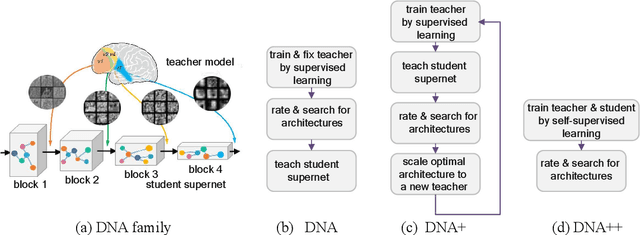
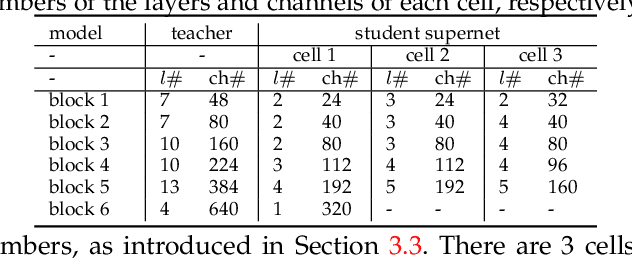
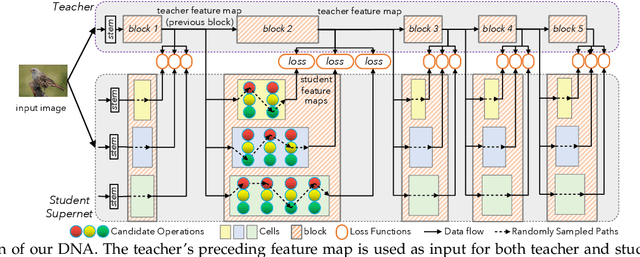
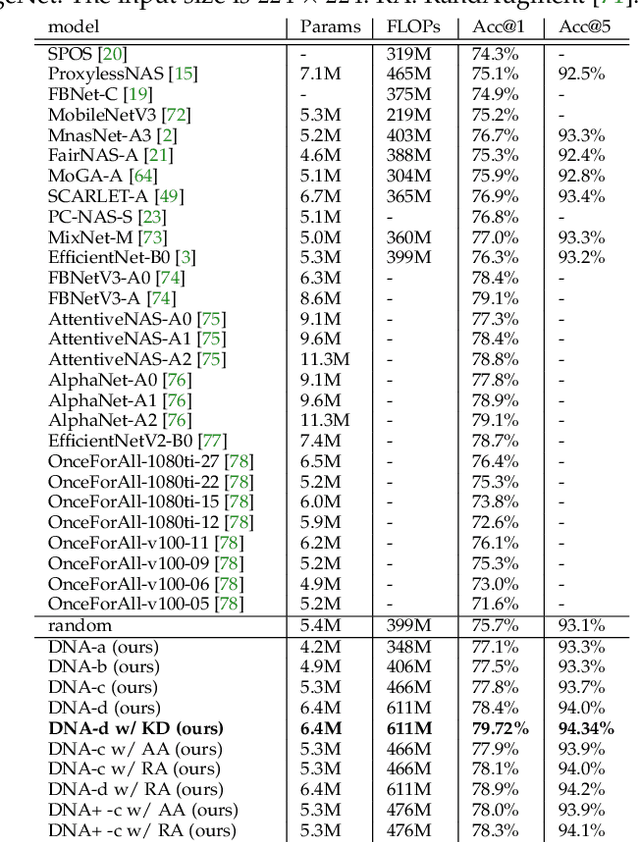
Abstract:Neural Architecture Search (NAS), aiming at automatically designing neural architectures by machines, has been considered a key step toward automatic machine learning. One notable NAS branch is the weight-sharing NAS, which significantly improves search efficiency and allows NAS algorithms to run on ordinary computers. Despite receiving high expectations, this category of methods suffers from low search effectiveness. By employing a generalization boundedness tool, we demonstrate that the devil behind this drawback is the untrustworthy architecture rating with the oversized search space of the possible architectures. Addressing this problem, we modularize a large search space into blocks with small search spaces and develop a family of models with the distilling neural architecture (DNA) techniques. These proposed models, namely a DNA family, are capable of resolving multiple dilemmas of the weight-sharing NAS, such as scalability, efficiency, and multi-modal compatibility. Our proposed DNA models can rate all architecture candidates, as opposed to previous works that can only access a subsearch space using heuristic algorithms. Moreover, under a certain computational complexity constraint, our method can seek architectures with different depths and widths. Extensive experimental evaluations show that our models achieve state-of-the-art top-1 accuracy of 78.9% and 83.6% on ImageNet for a mobile convolutional network and a small vision transformer, respectively. Additionally, we provide in-depth empirical analysis and insights into neural architecture ratings. Codes available: \url{https://github.com/changlin31/DNA}.
AlignMiF: Geometry-Aligned Multimodal Implicit Field for LiDAR-Camera Joint Synthesis
Feb 27, 2024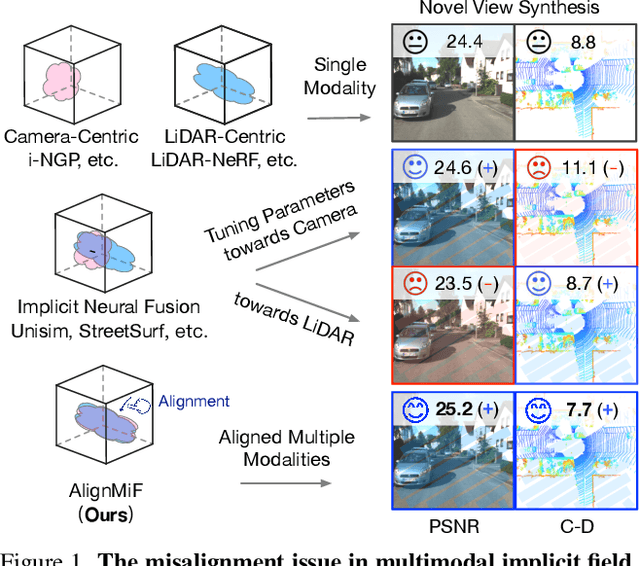
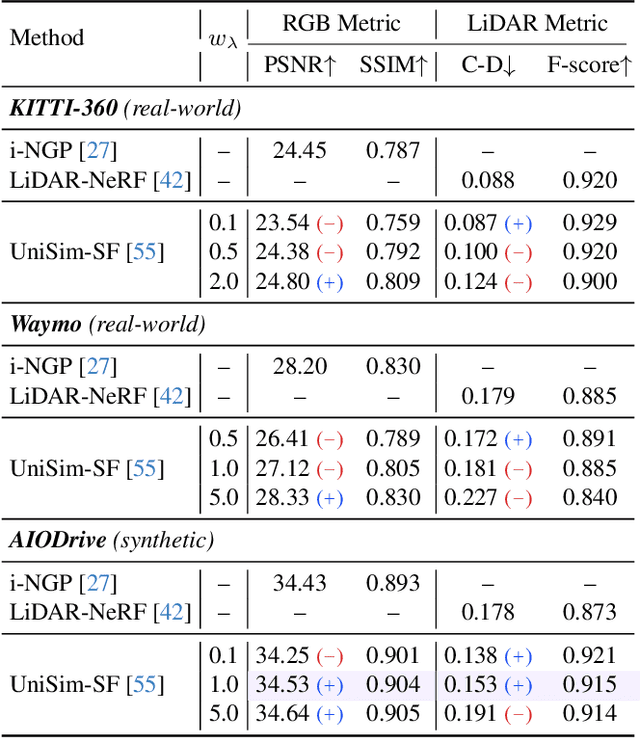
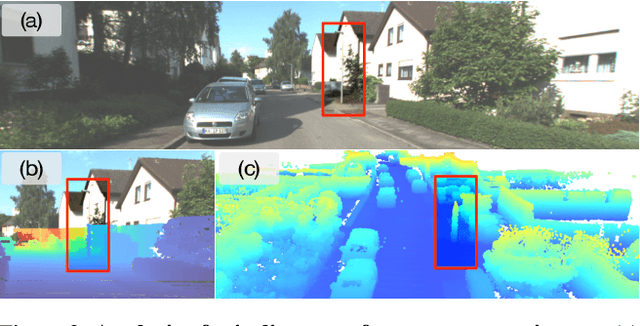
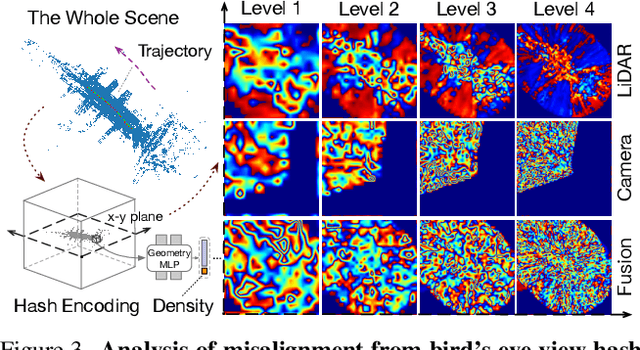
Abstract:Neural implicit fields have been a de facto standard in novel view synthesis. Recently, there exist some methods exploring fusing multiple modalities within a single field, aiming to share implicit features from different modalities to enhance reconstruction performance. However, these modalities often exhibit misaligned behaviors: optimizing for one modality, such as LiDAR, can adversely affect another, like camera performance, and vice versa. In this work, we conduct comprehensive analyses on the multimodal implicit field of LiDAR-camera joint synthesis, revealing the underlying issue lies in the misalignment of different sensors. Furthermore, we introduce AlignMiF, a geometrically aligned multimodal implicit field with two proposed modules: Geometry-Aware Alignment (GAA) and Shared Geometry Initialization (SGI). These modules effectively align the coarse geometry across different modalities, significantly enhancing the fusion process between LiDAR and camera data. Through extensive experiments across various datasets and scenes, we demonstrate the effectiveness of our approach in facilitating better interaction between LiDAR and camera modalities within a unified neural field. Specifically, our proposed AlignMiF, achieves remarkable improvement over recent implicit fusion methods (+2.01 and +3.11 image PSNR on the KITTI-360 and Waymo datasets) and consistently surpasses single modality performance (13.8% and 14.2% reduction in LiDAR Chamfer Distance on the respective datasets).
MUSTARD: Mastering Uniform Synthesis of Theorem and Proof Data
Feb 14, 2024Abstract:Recent large language models (LLMs) have witnessed significant advancement in various tasks, including mathematical reasoning and theorem proving. As these two tasks require strict and formal multi-step inference, they are appealing domains for exploring the reasoning ability of LLMs but still face important challenges. Previous studies such as Chain-of-Thought (CoT) have revealed the effectiveness of intermediate steps guidance. However, such step-wise annotation requires heavy labor, leading to insufficient training steps for current benchmarks. To fill this gap, this work introduces MUSTARD, a data generation framework that masters uniform synthesis of theorem and proof data of high quality and diversity. MUSTARD synthesizes data in three stages: (1) It samples a few mathematical concept seeds as the problem category. (2) Then, it prompts a generative language model with the sampled concepts to obtain both the problems and their step-wise formal solutions. (3) Lastly, the framework utilizes a proof assistant (e.g., Lean Prover) to filter the valid proofs. With the proposed MUSTARD, we present a theorem-and-proof benchmark MUSTARDSAUCE with 5,866 valid data points. Each data point contains an informal statement, an informal proof, and a translated formal proof that passes the prover validation. We perform extensive analysis and demonstrate that MUSTARD generates validated high-quality step-by-step data. We further apply the MUSTARDSAUCE for fine-tuning smaller language models. The fine-tuned Llama 2-7B achieves a 15.41% average relative performance gain in automated theorem proving, and 8.18% in math word problems. Codes and data are available at https://github.com/Eleanor-H/MUSTARD.
GS-CLIP: Gaussian Splatting for Contrastive Language-Image-3D Pretraining from Real-World Data
Feb 13, 2024


Abstract:3D Shape represented as point cloud has achieve advancements in multimodal pre-training to align image and language descriptions, which is curial to object identification, classification, and retrieval. However, the discrete representations of point cloud lost the object's surface shape information and creates a gap between rendering results and 2D correspondences. To address this problem, we propose GS-CLIP for the first attempt to introduce 3DGS (3D Gaussian Splatting) into multimodal pre-training to enhance 3D representation. GS-CLIP leverages a pre-trained vision-language model for a learned common visual and textual space on massive real world image-text pairs and then learns a 3D Encoder for aligning 3DGS optimized per object. Additionally, a novel Gaussian-Aware Fusion is proposed to extract and fuse global explicit feature. As a general framework for language-image-3D pre-training, GS-CLIP is agnostic to 3D backbone networks. Experiments on challenging shows that GS-CLIP significantly improves the state-of-the-art, outperforming the previously best results.
MapGPT: Map-Guided Prompting for Unified Vision-and-Language Navigation
Jan 14, 2024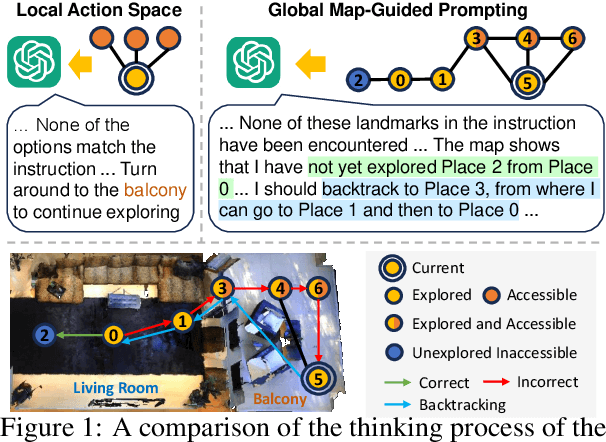
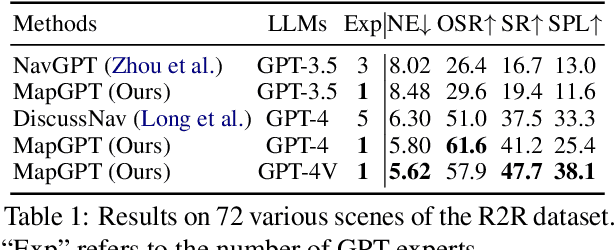
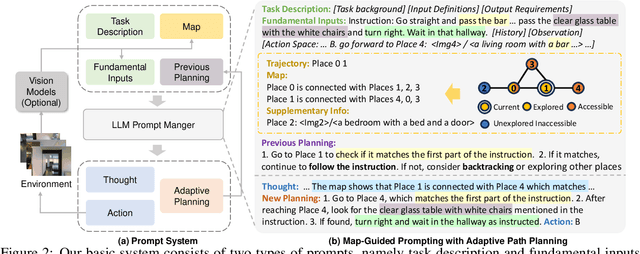
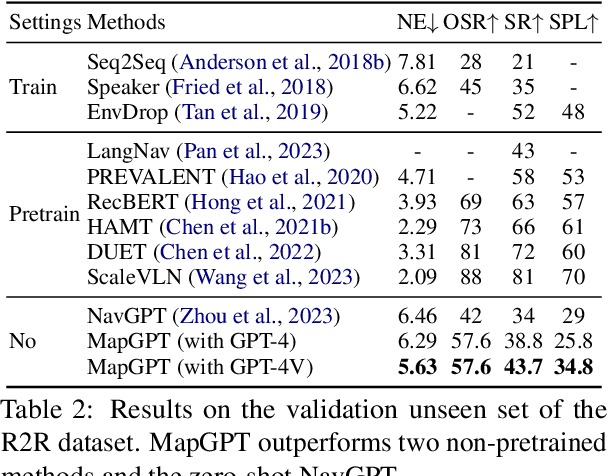
Abstract:Embodied agents equipped with GPT as their brain have exhibited extraordinary thinking and decision-making abilities across various tasks. However, existing zero-shot agents for vision-and-language navigation (VLN) only prompt the GPT to handle excessive environmental information and select potential locations within localized environments, without constructing an effective ''global-view'' (e.g., a commonly-used map) for the agent to understand the overall environment. In this work, we present a novel map-guided GPT-based path-planning agent, dubbed MapGPT, for the zero-shot VLN task. Specifically, we convert a topological map constructed online into prompts to encourage map-guided global exploration, and require the agent to explicitly output and update multi-step path planning to avoid getting stuck in local exploration. Extensive experiments demonstrate that our MapGPT is effective, achieving impressive performance on both the R2R and REVERIE datasets (38.8% and 28.4% success rate, respectively) and showcasing the newly emerged global thinking and path planning capabilities of the GPT model. Unlike previous VLN agents, which require separate parameters fine-tuning or specific prompt design to accommodate various instruction styles across different datasets, our MapGPT is more unified as it can adapt to different instruction styles seamlessly, which is the first of its kind in this field.
Holistic Autonomous Driving Understanding by Bird's-Eye-View Injected Multi-Modal Large Models
Jan 02, 2024
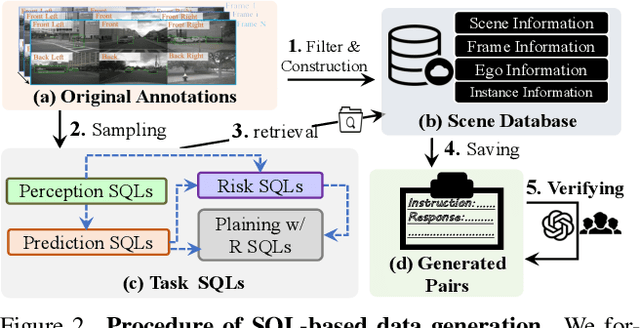
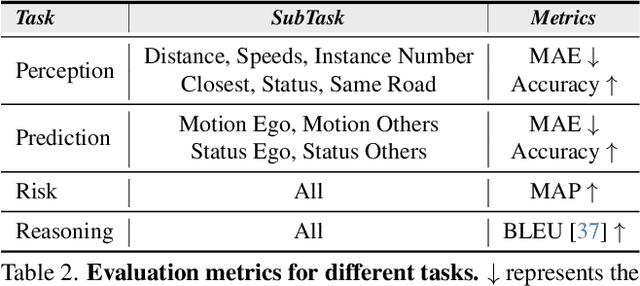

Abstract:The rise of multimodal large language models (MLLMs) has spurred interest in language-based driving tasks. However, existing research typically focuses on limited tasks and often omits key multi-view and temporal information which is crucial for robust autonomous driving. To bridge these gaps, we introduce NuInstruct, a novel dataset with 91K multi-view video-QA pairs across 17 subtasks, where each task demands holistic information (e.g., temporal, multi-view, and spatial), significantly elevating the challenge level. To obtain NuInstruct, we propose a novel SQL-based method to generate instruction-response pairs automatically, which is inspired by the driving logical progression of humans. We further present BEV-InMLLM, an end-to-end method for efficiently deriving instruction-aware Bird's-Eye-View (BEV) features, language-aligned for large language models. BEV-InMLLM integrates multi-view, spatial awareness, and temporal semantics to enhance MLLMs' capabilities on NuInstruct tasks. Moreover, our proposed BEV injection module is a plug-and-play method for existing MLLMs. Our experiments on NuInstruct demonstrate that BEV-InMLLM significantly outperforms existing MLLMs, e.g. around 9% improvement on various tasks. We plan to release our NuInstruct for future research development.
 Add to Chrome
Add to Chrome Add to Firefox
Add to Firefox Add to Edge
Add to Edge